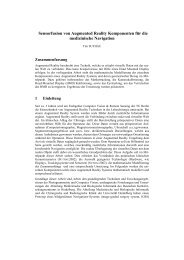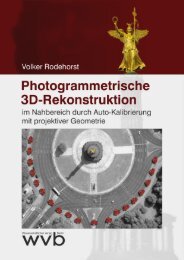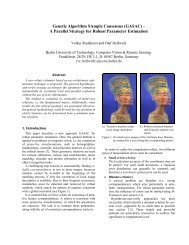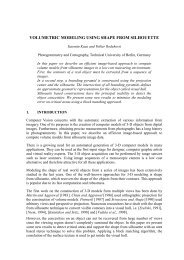Scatterer Characterisation Using Polarimetric SAR Tomography
Scatterer Characterisation Using Polarimetric SAR Tomography
Scatterer Characterisation Using Polarimetric SAR Tomography
Create successful ePaper yourself
Turn your PDF publications into a flip-book with our unique Google optimized e-Paper software.
Let define �a ′ d = �ad/��ad� = [B ′ d ] � f ′ d as the normalised<br />
steering vector of �ad with {[B ′ d ]=[�b ′ 1(zd) �b ′ 2(zd)]} D d=1 .It<br />
can be shown that the ratio between the two elements of � f ′ d<br />
corresponds to the polarisation ratio ρEd � . The estimation of<br />
�f ′ d is given by calculating the eigenvector of the Hermitian<br />
matrix [B ′ d ]† [EN ][EN ] † [B ′ d ], corresponding the the smallest<br />
eigenvalue.<br />
Finally, the two polarimetric angles {γd} D d=1 and {δd} D d=1<br />
can be determined uniquely from:<br />
γd = tan −1<br />
� �<br />
�<br />
� 1<br />
�<br />
�<br />
� �<br />
�ρEd<br />
� � with δd = − arg ρEd � (11)<br />
From the spheric angle, it is possible to estimate the<br />
orientation φ and the ellipticity τ angles characterising the<br />
polarisation ellipse. The relations between all different angles<br />
are:<br />
tan 2φ = tan 2γ cos δ<br />
sin 2τ = sin2γsin δ (12)<br />
height (m)<br />
height (m)<br />
655<br />
645<br />
635<br />
625<br />
655<br />
645<br />
635<br />
625<br />
forest<br />
MUSIC (5) - PHI<br />
street<br />
building<br />
corner<br />
reflector<br />
ground<br />
0 100 200 300 400 500<br />
azimuth position (pixels)<br />
MUSIC (5) - TAU<br />
forest<br />
street<br />
building<br />
corner<br />
reflector<br />
ground<br />
0 100 200 300 400 500<br />
azimuth position (pixels)<br />
+15 ◦<br />
angles (deg) −15◦<br />
+15 ◦<br />
angles (deg) −15◦<br />
Fig. 5. Angles characterising the polarisation ellipse. Top Orientation angle<br />
φ. Bottom Ellipticity angle τ<br />
Fig. 5 presents results of this polarimetric approach of<br />
the <strong>SAR</strong> tomography, using HH and VH polarisation data.<br />
It represents the orientation φ and the ellipticity τ angles<br />
retrieved using the polarimetric MUSIC approach, assuming 5<br />
scatterers. These results show that the retrieved polarisations<br />
are media depending. The polarisation state responses of the<br />
forest ground and the grass field are not the same. The<br />
response of the ground over the forest is a linear polarisation<br />
(τ =0◦ ) with an orientation about 15◦ , whereas the polarisation<br />
over the grass field is horizontal linear polarisation,<br />
characteristic of a surface reflection by a wave emitted in<br />
a horizontal polarisation. Over the building, the polarisation<br />
state is similar with that the ground under the forest. Over the<br />
forest canopy, polarimetric responses are random, as it can be<br />
expected from the random behaviour of this kind of media.<br />
This polarimetric approach of the <strong>SAR</strong> tomography shows<br />
that the polarimetric behaviour is depending with the media<br />
observed and make it possible to characterise partially targets<br />
in terms of height position but also by their physical properties.<br />
IV. CONCLUSION<br />
This paper presents the first step into polarimetric <strong>SAR</strong><br />
tomography. In a first part, hight resolution methods were used<br />
to generate high quality tomograms. The results obtained show<br />
an improvement compared to the initial results, and different<br />
scatterers have been detected. Nevertheless, unless having<br />
the ground-truth of the area under study, the mono-channel<br />
approach of the <strong>SAR</strong> tomography does not make it possible<br />
to identify the nature of the scattering mechanism detected.<br />
For stage with this disadvantage, a polarimetric approach of<br />
the <strong>SAR</strong> tomography approach is proposed. Like the Caponbased<br />
result data are not coherent and it is not possible to apply<br />
to the obtained data a simple polarimetric decomposition like,<br />
for instance, the Pauli decomposition, which is related to some<br />
basic scattering mechanisms, a polarisation state estimation<br />
based on a extension of the MUSIC algorithm has been<br />
proposed. This method takes into account partially polarised<br />
data. It is shown that the polarimetric behaviour is depending<br />
with the observed media and the partial characterisation of the<br />
target is possible. In the future, a use of fully polarimetric data<br />
will be necessary to completely characterize the objects.<br />
ACKNOWLEDGMENT<br />
This work was supported by the German Science Foundation<br />
DFG, under project No. RE 1698/1.<br />
REFERENCES<br />
[1] A. Reigber and A. Moreira, “First Demonstration of Airborne <strong>SAR</strong><br />
<strong>Tomography</strong> using Multibaseline L-band Data,” IEEE Trans. Geosci.<br />
Remote Sensing, vol. 38, pp. 2142–2152, September 2000.<br />
[2] F. Lombardini and A. Reigber, “Adaptive Spectral Estimation for<br />
Multibaseline <strong>SAR</strong> <strong>Tomography</strong> with Airborne L-band Data,” in Proc.<br />
IGARSS’03, (Toulouse, France), July 2003.<br />
[3] S. Guillaso and A. Reigber, “<strong>Polarimetric</strong> <strong>SAR</strong> <strong>Tomography</strong>,” in Proc.<br />
POLI<strong>SAR</strong>’05, (Frascati, Italy), 2005.<br />
[4] S. Guillaso, A. Reigber, and L. Ferro-Famil, “Evaluation of the ESPRIT<br />
Approach in <strong>Polarimetric</strong> Interferometric <strong>SAR</strong>,” in Proc. IGARSS’05,<br />
(Seoul, Korea), Jul. 2005.<br />
[5] P. Stoica and R. Moses, Introduction to Spectral Analysis. N. J.: Prentice<br />
Hall, 1997.<br />
[6] A. Reigber, P. Prats, and J. J. Mallorqui, “Refined estimation of<br />
time-varying baseline errors in airborne <strong>SAR</strong> interferometry,” in Proc.<br />
IGARSS’05, (Seoul, Korea), Jul. 2005.<br />
[7] S. R. Cloude and E. Pottier, “An Entropy Based Classification Scheme<br />
for Land Applications of <strong>Polarimetric</strong> <strong>SAR</strong>,” IEEE Trans. Geosci. Remote<br />
Sensing, vol. 35, pp. 68–78, Jan. 1997.<br />
[8] E. Ferrara and T. Parks, “Direction finding with an array of antennas<br />
having diverse polarizations,” IEEE Trans. Antennas Propagat., vol.AP-<br />
31, pp. 231–236, March 1983.








